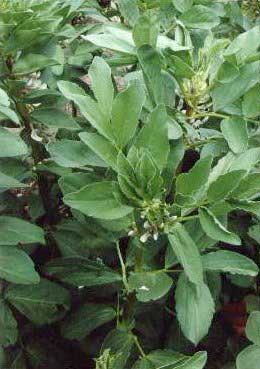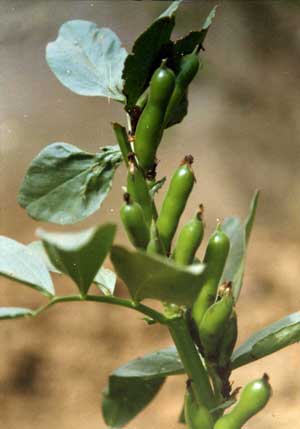(Vicia Faba "Martock")
The history of the Martock bean, how to grow, when to harvest and where to buy
Family: Fabacceae.
Genus: Vicia.
Species: Faba.
Cultivar: Martock.
The Broad Bean (Vicia Faba) was developed in the eastern Mediterranian area in Neolithic times, the earliest evidence of their cultivation coming from as far apart as Hungary and Jericho, with early remains also having been found in Egypt and England. They are the hardiest of all beans.

The cultivar "Martock", probably the last of the truly local varieties of field bean, dates from the medieval period and was grown extensively in England in the Middle Ages. It was first mentioned in parish records as early as the 12th century, although it is thought to be the same variety used in the Roman voting system, a brown/black "Martock" bean being used to cast a "No" vote and a white bean for a "Yes", eventually giving rise to being black-balled to bar membership to a club. Black and white balls taking the place of beans. Beans turn black after several years of storage.
The Royal Botanic Gardens at Kew describe that "It has been grown for many years and takes its name from the village of Martock in Somerset, where it was grown in the 12th century, where it was dried and used for bean feasting". Nevertheless, it is important to realise that it was never a luxury food used only for feast days; it was an essential component of the average medieval survival diet. The Heritage Seed Library catalogue says that it was rediscovered preserved in the kitchen garden of the Bishop of Bath and Wells, probably not much changed from the small-seeded beans that were the mainstay of a medieval feast. Robust, with small pods, a real survivor with a meaty taste that was welcome on fast days. Bees only work small areas at a time and beans are, in any case, largely self-pollinating, so what was growing in the Bishop's garden has probably altered very little from the original beans. It is most probably a "landrace" variety, that is, a primitive or antique variety usually associated with traditional agriculture, the result of generations of farmers retaining the best beans for the following year's seed, resulting in a crop often highly adapted to local conditions. In an average season a single Martock bean plant can produce over a hundred beans; a much better yield than wheat, which in medieval times only multiplied by five times at best. Fergus Dowding relates that "When I first grew the bean I sowed eight seeds and harvested several hundred a few months later. They are delicious fresh, quite as good as modern varieties of broad bean, only smaller".
In medieval times Martock beans were usually dried and then subsequently used in soups, stews and gruels, the mainstay of the medieval peasant's winter diet. The deep clay loam soil common in this area grows heavy crops of beans and in 1633 Thomas Gerard wrote that Martock was "seated in the fattest place of the Earth of this Countie, especially for errable, which makes ye inhabitants soe fatt in their purses...". The bean helped to make Martock a prosperous place "inhabited by wealthy and substantial men". Some idea of the economic importance of the bean can be seen in the Will of Thomas Goodden of Ayshe, dated 28th September 1643, in which he leaves to his wife Elizabeth "six plough oxen, six milch kyne, 40 bushells of wheat, 40 bushells of beans and fifty pounds in money, together with one wayne and a pair of wheels with plough for her six oxen" We therefore have the bean to thank for many of our beautiful hamstone buildings. Indeed, there was a saying, recorded in the 18th century, "Take a Martock man by the collar and shake him, and you will hear the beans rattle in his belly". (Somerset Record Office, DD/CC 116013).

One crop, beans, seems to have been characteristic of the whole parish since the middle ages, but as life in rural England became more and more prosperous, more people could afford wheat to make bread. Nevertheless, beans remained the peasant's diet for centuries, hence the saying that a man down on his uppers, i.e. very poor, "isn't worth a bean". By contrast, the saying that someone is "full of beans" reflects that beans were a major source of a working man's energy.
The plants themselves are strong, healthy plants with pink and mauve flowers which develop into numerous clusters of finger-sized pods each containing three or four smallish beans about the size of a large pea but with the appearance of a small modern broad bean. Unusually, the pods grow upwards rather than hanging downwards like the modern broad beans and, just like their modern counterparts, they are very prone to blackfly. The beans are very tender when cooked, somewhat smaller and less starchy than the usual beans, with a sweet, meaty taste.
We should all be very thankful to the Henry Doubleday Research Association for saving this wonderful and historic bean. Garden Organic is the working arm of the HDRA, the national charity for organic growing and from whom it is possible to purchase seeds. We now sell the bean ourselves, as we think it must be good to grow them in the soil from which they originally came.
|
A number of us grow this delicious bean in Martock. Grow them exactly as for ordinary bean: sow in March or April at a depth of 2". the more organic matter in the soil, the better they grow. in June watch out for the black fly, nip out the tops as soon as you see the first one. stake the plants if your crop is heavy, harvest in July. Unfortunately we have no beans to sell at present due to a poor harvest. |
Acknowledgements: Special thanks to Fergus Dowding for help and collaboration in writing this article and to Michael Goodden of Over Compton for bringing my attention to the Will of his ancestor, Thomas Goodden.
Finally, if there are any local growers of the Martock Bean, then the author Will Aslett or Fergus Dowding would like to hear from you.